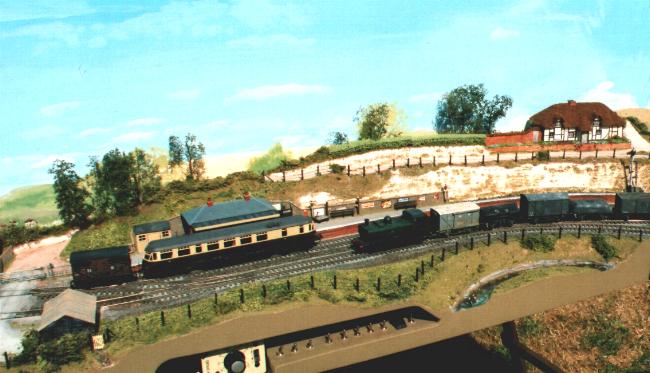 |
"Most passenger services were 3rd class only and
provided
by a brand new Diesel Railcar built in 1941."
indentThe Great Western had been notable
users of Steam railmotors in the early part of the century but they had all gone by the
Second World War. To replace them, ordinary locos fitted with "Auto gear"
and coaches with a driver's compartment were used (the famous "auto coaches" -
often themselves conversions from steam railmotors), until in 1936, the GWR introduced the
first diesel railcars for both branch and main line use. They were successful but
when more came to be made during the early days of the war a more practical, if
utilitarian shape with angled corners was used, as opposed to the streamlined 30s styling
of the originals.
indentThis is the diagram chosen by Lima for their now quite
elderly 4mm scale model. However the basic moulding is pretty accurate and with a
few minor modifications and some detailing a useful model with unique character can be
cheaply provided.
indentThe originals did not have buffers and normal coupling
gear but the last two streamlined versions and all the later angular ones did and were
rated for a tail load of 60 tons. This is useful on a model like this in that the
whole unit - if the headshunt is made long enough to enable the railcar to clear the
points - can be used to do some shunting so adding to the operating interest.
Typical tail loads included cattle vans, horse boxes, perhaps an extra coach (or even two,
rarely), or perishable goods such as locally grown fruit, cheese or milk.
indentOn most layouts you have to bring such traffic on with the railcar's first appearance and can only add an out-going load during its last visit because there's nowhere to uncouple it. On this layout however, because the hidden sidings are reversed into by outgoing trains, a suitably-placed uncoupler can relieve the railcar of its tail-load between visits so making operation all the more interesting!
indentAnd here I must admit to a mistake! We all make them, professional and amatuer alike and here's one of mine. The quarter light frames I've added to the ends of the sides should be painted black. At the time I made the model I had found no pre-Nationalisation photos of this type of railcar actually in service and all the ones I did have showed cream quarterlights as I have painted them. However, I have since found 4 or 5 late Great Western period views showing them to be black. As the model is now with the customer I can no longer change it but just in case anyone was using this as a reference for repainting their own model...
| Previous photograph in series | Back to "Upper Isis Room" entrance | Next photograph in series |